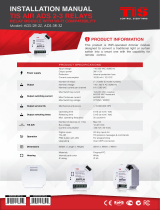
TT31 Transponder Installation Manual 1 February 2010
00455-00 Issue AJ
______________________
arus/Trimble/Garmin” format altitude data, or “RMS”
ocumentation to determine jumper settings as appropriate.
232
erted when the voltage to ground is pulled below
put
e
ode. It should be used to switch
nd is pulled below approximately 4 Volts.
the 12 way secondary connector. The Audio Output is a balanced (two wire)
to an unswitched input on the aircraft audio panel. Audio output is
s the pair when driving a 600 Ohm load; actual level can be adjusted
e
der to warn the pilot. The
transistor, and can sink up to 1 Amp DC. The switched voltage should not
and is on the 12 way secondary connector. The ADS-B features are
optional
The TT31 will correctly recognise either “Ic
fo
rmat altitude data. Refer to the encoder d
The TT31 includes a serial altitude output which repeats the altitude received on the encoded input
(either parallel or serial) for connection to a GPS or other equipment. The serial output supplies RS
output levels, and runs at 9600 bps, no parity. The output format is always “Icarus/Trimble/Garmin”
format. If the altitude source is a parallel encoder, the serial output is reported every 0.5 seconds; if the
source is a serial encoder, the output simply repeats the input reports, each report delayed by up to 10
milliseconds from the corresponding input report.
5.5.5 Ident Switch Input
The Ident switch input, on the 24 way connector, allows the IDENT function to be selected using a
remote switch. The input is active low, and will be ass
approximately 4 Volts.
5.5.6 Squat Switch Input
The Squat switch input allows the transponder to automatically switch between Airborne and Ground
modes of operation. The squat switch will also automatically start and stop the flight timer. The in
will be asserted when the voltage to ground is pulled below approximately 4 Volts. The operating mod
of the squat switch can be programmed during setup to allow for active low or active high logical
behaviour. For aircraft with no squat switch this input should be left open circuit, and the setup mode
programmed for “Not Connected”.
5.5.7 External Standby Input
This input, when held low, places the transponder in Standby m
between transponders in an installation with two transponders. The input is active low, and will be
asserted when the voltage to grou
5.5.8 Audio Output
The Audio Output is on
audio output that can be connected
up to 10 Volts peak-to-peak acros
at installation – see Section 6.
Note: The audio pair is not a true transformer balanced output – both pins are actively driven.
If the audio panel input is single-ended, then only one of the output pins should be used,
together with a local ground pin – the other audio output should be left floating.
The Audio Output carries the traffic alert messages for TIS, and the altitude audio annunciator used by
the altitude monitor function.
5.5.9 Altitude Alerter Output
The TT31 includes an altitude monitor function that can alert the pilot to altitude deviations in cruise
flight. The altitude alerter output, on the 12 way secondary connector, is switched to ground when th
altitude deviation is detected and can be connected to a warning light or soun
output is an open collector
exceed 60 Volts.
5.5.10 GPS Position Input
The GPS position input is required to support ADS-B functionality. The GPS position input is an
RS232 input to the transponder
– no GPS is required for normal Mode S Elementary Surveillance.
Trig Avionics Limited Page 11






















